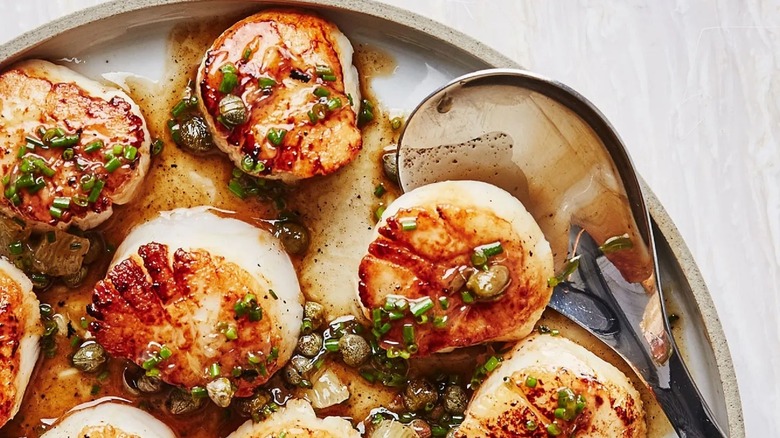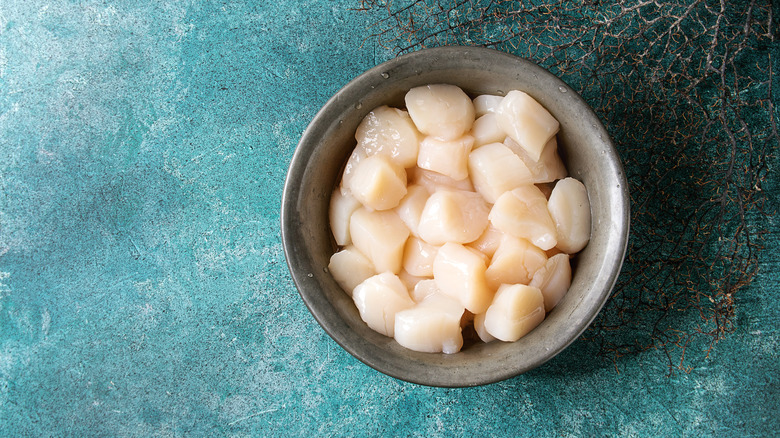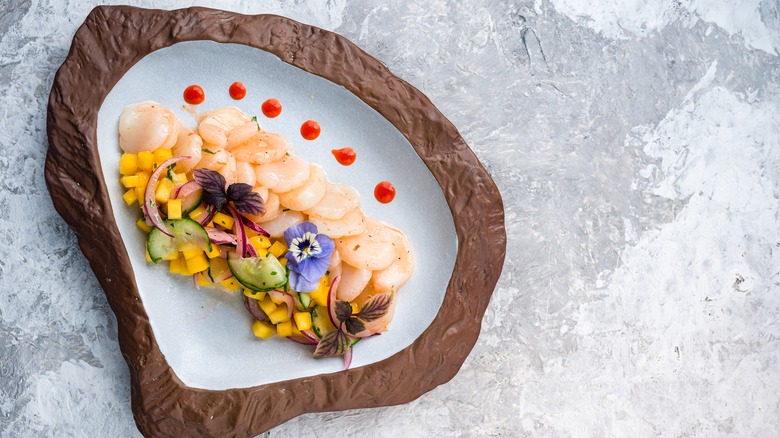Easily Prevent Gritty Scallops With A Sparkling Water Rinse
Some things are certainly worth spending a few extra dollars on at restaurants; maybe it's something you don't think you'd be able to master at home, or the meal would cost you more time and money than it's worth to put together yourself. Scallops, while they can no doubt be deliciously prepared at seafood spots and steakhouses, are not one of those things.
These meaty mollusks will cost you a pretty penny no matter what, but they're extremely easy to cook yourself — so why not spend $32 for a pound rather than $32 for a small plate of them? Whether you bake, broil, grill, or sear, your scallops will be ready to eat in minutes, and all they need is some butter and a few aromatics to taste divine.
But if you're going to spend a pretty penny, you want to make sure those scallops look and taste as pretty as possible ... and that means getting them sparkling clean. Because the last thing you want is to spend $32 only to chew on a few rogue pieces of grainy sand. Next time you're in the mood to splurge on scallops, try using sparkling water to make sure that doesn't happen.
For sparkling clean scallops, go for sparkling water
Rather than rinsing your scallops under the tap or soaking them in cold water, as many recipes may recommend, Adebola Adeshina, chef patron at Chubby Castor in Cambridgeshire has a great trick for ensuring the mollusks are sand and dirt-free: use sparkling water instead. He swears by this method, telling The Guardian that "the bubbles will remove any hidden grit."
Cleaning is crucial to your scallop-eating experience, because you may not realize when you buy or cook your scallops that there's sand and grit buried inside the muscle. Scallops are bivalves, meaning they have a soft body with a hinged, two-part shell, just like clams, mussels, and oysters. They reside on the seafloor and filter water through their bodies, which is why some of that ocean grit can be found on them even though they may look clean.
Because the carbonation in sparkling water helps to break up particles and loosen dirt or other fragments, it'll give you an added edge when cleaning your scallops to remove any hard-to-reach or hidden sand. And that goes for other mollusks, like clams and mussels, too, when soaking and cleaning their shells. Go for sparkling water over still to get the best results so you can enjoy everything you love about these shellfish (and nothing you don't).
How to make scallops at home
One of the best ways to cook scallops is to simply give them a good sear on a hot pan or a grill. A couple of tips for searing: first (after they're sparkling clean), make sure you pat them dry so there's no moisture hitting the cooking surface. Season them well, and make sure your pan is preheated and nice and hot. Scallops take very minimal time to cook — all they need is about two minutes on each side to achieve a nice sear and fully cook. Don't move them around; let them do their thing until they've got a golden-brown crisp on the outside and a tender middle. A similar result can be achieved in the broiler by broiling them on high for about three to four minutes on each side. From there, the sweet, tender seafood pairs wonderfully with butter, lemon, white wine, garlic, herbs, and briny flavors like capers.
If you're in the mood to keep things fresh, you can also forego the cooking and opt for some scallop ceviche. Good-quality scallops taste great raw with a few fresh flavors to brighten them up. To make a ceviche, bay scallops work best since they're already small in size. Just use a citrus juice like fresh lime or orange juice, and add whatever herbs and aromatics you like — things like cilantro, mint, red onion, mango, or jalapeno.


